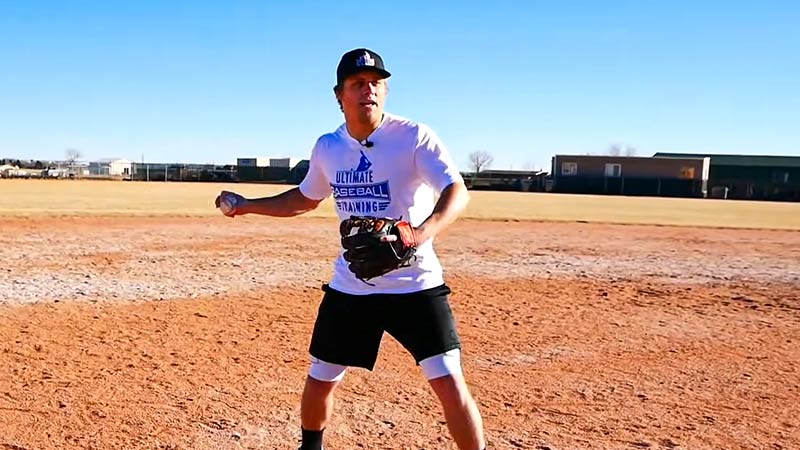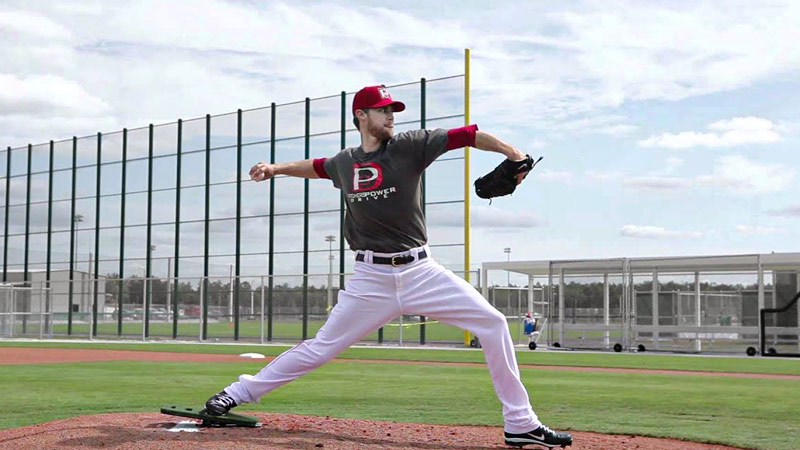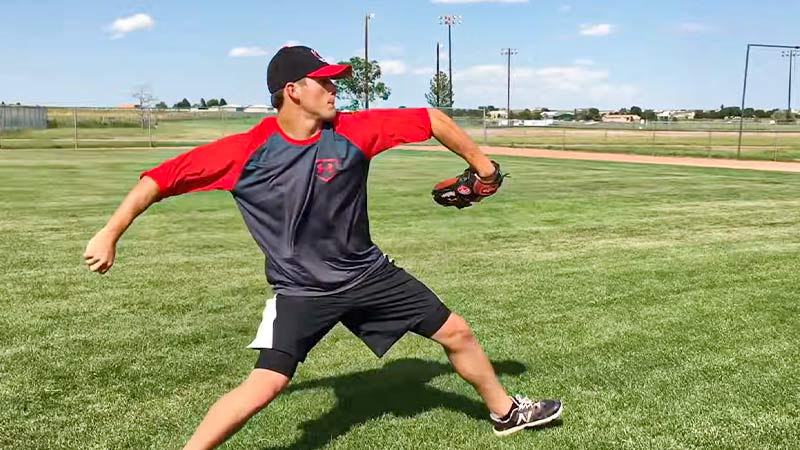In baseball, throwing harder can make a significant difference in a player’s performance. Whether it’s for pitching or fielding positions, increasing throwing velocity requires a comprehensive approach that includes proper technique, strength training, conditioning, and more.
This guide explores key factors to help athletes improve their throwing velocity and excel on the field. So, let’s not skip a single part and check out all the details. Only then you’ll understand exactly what to do for throwing a baseball harder than most players.
How to Increase Throwing Velocity in Baseball?
Increasing throwing velocity in baseball requires a combination of strength training, technique refinement, flexibility and mobility work, mental preparation, and consistent practice. Here are some steps you can take to enhance your throwing velocity:
Warm-up and Conditioning
Proper warm-up routines and conditioning play a crucial role in improving throwing velocity in baseball. Before engaging in any intense physical activity, it is essential to prepare the body for the demands it will face.
A well-designed warm-up routine not only helps prevent injuries but also optimizes performance by increasing blood flow to the muscles and improving joint mobility.
Proper warm-up routines serve as a foundation for a successful throwing session. They prepare the body both mentally and physically for the demands of throwing a baseball.
Dynamic stretches and exercises are an essential component of a baseball warm-up routine. Unlike static stretches that involve holding a stretch position, dynamic stretches involve continuous movement that mimics the actions performed during the sport.
While warm-up routines are essential, overall conditioning of the body is equally important for improving throwing velocity. Conditioning refers to the process of gradually improving one’s physical fitness through regular exercise and training.
Building Strength for Power
Building strength is a fundamental aspect of increasing throwing velocity in baseball. By targeting the specific muscle groups involved in throwing, athletes can enhance their power output and generate more forceful throws.
Weightlifting exercises and resistance training techniques play a crucial role in developing the necessary strength and power for improved throwing velocity.
To effectively build strength for throwing, it is essential to understand the primary muscle groups involved in the throwing motion.
The major muscle groups utilized in throwing include the shoulder muscles (deltoids, rotator cuff muscles), arm muscles (biceps, triceps, forearm muscles), and core muscles (abdominals, obliques, lower back).
Weightlifting exercises are an effective way to target and strengthen the muscles involved in throwing. In addition to weightlifting exercises, resistance training techniques can be employed to enhance power generation during throws.
Perfecting Throwing Mechanics
Throwing mechanics are a critical aspect of maximizing throwing velocity in baseball. By focusing on footwork, body positioning, arm motion, and release techniques, athletes can optimize their throwing mechanics to generate optimal power transfer and increase throwing velocity.
Footwork and body positioning are fundamental components of effective throwing mechanics. By positioning the body in the right stance and utilizing proper footwork, athletes can generate maximum power transfer from the lower body to the upper body during the throwing motion.
The arm motion and release techniques play a crucial role in throwing mechanics. By focusing on proper arm mechanics, athletes can generate more speed and power during the throwing motion.
To perfect throwing mechanics, it is helpful to break down the throwing motion into specific steps and focus on each phase individually.
The throwing motion can be divided into the wind-up, the stride, the arm cocking phase, the arm acceleration phase, and the release.
Core Strength and Stability
Core strength and stability are vital components of a successful throwing motion in baseball.
A strong and stable core provides a solid foundation for generating power, maintaining proper body control, and transferring force from the lower body to the upper body during the throwing motion.
By focusing on core exercises and incorporating rotational movements, athletes can enhance their core strength, and stability, and ultimately increase their throwing velocity.
A strong and stable core is essential for optimal performance in throwing. The core muscles, including the abdominals, obliques, and lower back, act as a link between the lower and upper body.
Incorporating core exercises into training routines is crucial for developing core strength and stability in throwing. These exercises target the muscles involved in core activation and contribute to increased power generation during the throwing motion.
Rotational movements are particularly important for increasing throwing velocity. By incorporating exercises that involve rotational movements, athletes can enhance their ability to generate power through the core and transfer that power into the throwing motion.
Flexibility and Range of Motion

Flexibility and range of motion are crucial aspects of an efficient and fluid throwing motion in baseball. By prioritizing flexibility, athletes can achieve a full range of motion in their joints, allowing for optimal mechanics, increased power generation, and reduced risk of injury.
Incorporating stretching exercises that target the shoulder, arm, and hip joints, as well as practices like yoga and Pilates, can greatly enhance overall flexibility and body control in throwing.
Flexibility plays a vital role in achieving a fluid and efficient throwing motion. Having adequate flexibility allows athletes to achieve a full range of motion in their joints, enabling smooth and unrestricted movement throughout the throwing motion.
Incorporating stretching exercises that specifically target the shoulder, arm, and hip joints can greatly enhance flexibility and range of motion in these areas, which are essential for an effective throwing motion.
Practices like yoga and Pilates offer comprehensive approaches to improving flexibility, body control, and overall athletic performance.
These disciplines focus on developing flexibility, strength, balance, and coordination through controlled movements and specific poses or exercises.
Long Toss and Distance Training
Long toss exercises and distance training play a significant role in developing arm strength, increasing throwing distance, and improving overall performance in baseball.
By understanding the benefits of long toss, implementing progressive routines, and maintaining accuracy and mechanics during sessions, athletes can maximize the advantages of this training method.
Long toss exercises offer numerous benefits for arm strength and throwing distance. By throwing the ball at longer distances, athletes can develop greater arm strength and endurance.
Implementing progressive long toss routines is crucial for gradual improvement and minimizing the risk of overexertion or injury. Athletes should start with shorter distances and gradually increase the throwing distance over time.
While long toss emphasizes distance, it is essential to maintain accuracy and proper mechanics throughout the sessions. Athletes should aim for their intended targets and focus on executing the throwing motion with precision.
Seeking Professional Guidance
Seeking professional guidance from a coach or trainer can greatly benefit baseball players looking to improve their throwing abilities.
Working with a knowledgeable and experienced professional provides valuable insights, personalized feedback, and the opportunity to design a tailored training program to meet individual needs.
Working with a coach or trainer offers numerous advantages in developing throwing skills. These professionals have extensive knowledge of the mechanics, techniques, and strategies involved in throwing a baseball.
They can provide guidance on proper form, body positioning, and the sequence of movements to maximize throwing efficiency and velocity. One of the primary benefits of working with a coach or trainer is receiving personalized feedback on technique and making necessary adjustments.
These professionals can observe and analyze the player’s throwing motion, identifying areas for improvement and offering specific guidance on how to refine mechanics, footwork, arm action, and other critical elements.
Coaches and trainers excel at designing tailored training programs that cater to an individual’s specific needs and goals. They consider various factors, such as the player’s age, skill level, physical attributes, and areas for improvement, to create a comprehensive and customized training plan.
Consistency and Patience
Throwing harder in baseball is not an overnight achievement. It requires time, consistent effort, and dedication to develop the necessary strength, mechanics, and technique.
Athletes must understand that progress is a gradual process and that significant improvements may take weeks, months, or even years to materialize.
Consistency is essential in training. Regularly practicing throwing drills, strength exercises and mobility routines ensures that athletes develop and maintain the necessary skills and physical capabilities needed to throw harder.
By committing to consistent training over an extended period, athletes lay the foundation for long-term improvement in their throwing abilities.
Baseball Pitching Velocity by Age

The baseball pitching velocity can vary based on the age and developmental stage of the player. Here’s a general overview of the average pitching velocity by age:
Little League (8-12 years old)
- At this age, pitchers are still developing their fundamental skills and are typically focused on throwing strikes and learning proper mechanics.
- Average pitching velocity ranges from 40-55 mph, with some exceptional young pitchers reaching speeds up to 60 mph.
Junior High School (13-14 years old):
- As players enter junior high school, they may start to show increased strength and improved mechanics.
- Average pitching velocity typically ranges from 55-65 mph, with some standout pitchers capable of reaching 70 mph.
High School Freshmen and Sophomores (15-16 years old)
- High school freshmen and sophomores are usually more physically developed and have been refining their pitching mechanics.
- Average pitching velocity generally falls within the range of 65-75 mph, with top pitchers reaching 80 mph or higher.
High School Juniors and Seniors (17-18 years old)
- At this stage, players have typically reached their peak physical development and have dedicated significant time to improving their pitching skills.
- Average pitching velocity ranges from 75-85 mph, with standout pitchers often throwing in the 85-90+ mph range.
College and Professional Level
- College and professional pitchers have usually undergone advanced training programs and possess exceptional skill and athleticism.
- Average pitching velocity at the college level can vary but often falls within the range of 85-95 mph.
- Professional pitchers typically throw in the 90-100+ mph range, with a few elite pitchers capable of reaching speeds over 100 mph.
It’s important to note that these velocity ranges are general estimates and individual variation exists. Factors such as genetics, training programs, mechanics, and dedication to improvement can all impact pitching velocity.
Additionally, it’s crucial for young pitchers to prioritize proper mechanics, arm care, and gradual progression to avoid overuse injuries and ensure long-term development.
Secrets of Throwing Baseball 100mph
Throwing a baseball at 100 mph is an impressive feat that requires a combination of physical attributes, proper mechanics, and dedicated training. While there are no “secrets” that guarantee to reach that velocity, here are some key factors to consider:
Natural Ability and Genetics
- Some individuals are naturally gifted with physical attributes such as fast-twitch muscle fibers, joint mobility, and overall athleticism, which can contribute to higher throwing velocities.
- However, it’s important to note that even without exceptional genetics, significant improvements in velocity can still be achieved through focused training and proper mechanics.
Efficient Mechanics
- Proper throwing mechanics are crucial for maximizing velocity. Seek guidance from knowledgeable coaches or trainers who can help refine your technique.
- Focus on generating power from the lower body, using hip rotation and leg drive to transfer energy through the kinetic chain.
- Emphasize a compact arm action, utilizing proper arm slots and timing to optimize the transfer of energy from the lower body to the arm.
Strength and Power Training
- Build overall body strength, with a specific focus on the lower body, core, and shoulder muscles.
- Incorporate resistance training exercises such as squats, deadlifts, and plyometrics to develop explosive power.
- Include exercises that target the specific muscles involved in the throwing motion, such as shoulder external rotations and forearm strengthening exercises.
Flexibility and Mobility
- Enhance flexibility and mobility to allow for a full range of motion during the throwing motion.
- Incorporate dynamic warm-up routines and stretching exercises for the entire body, paying particular attention to the shoulders, hips, and thoracic spine.
- Include mobility drills that improve the range of motion in key joints involved in throwing, such as shoulder and hip rotations.
Velocity-Specific Training
- Incorporate drills and exercises specifically designed to improve throwing velocities, such as weighted ball programs or resistance band exercises.
- Implementing long toss sessions helps to develop arm strength and increase throwing distance.
- It is also essential to utilize plyometric exercises and medicine ball throws to improve explosive power.
Mental Focus and Mindset
- Develop mental toughness, focus, and confidence in your abilities.
- Visualize yourself throwing with maximum velocity and success.
- Stay dedicated, patient, and motivated throughout the training process.
Consistent Practice and Feedback
- Regularly engage in focused practice sessions, including bullpen sessions and game simulations.
- Seek feedback from experienced coaches or trainers who can analyze your mechanics and provide guidance for improvement.
- Track your progress, adjust your training routine accordingly, and remain committed to consistent practice.
It is essential to remember that increasing velocity takes time, effort, and a comprehensive approach to training. It’s crucial to prioritize proper mechanics, injury prevention, and long-term development.
FAQs
Can I increase my throwing velocity even if I don’t have a strong arm?
Yes, while having a naturally strong arm can be advantageous, proper technique, strength training, and conditioning can help you improve your throwing velocity regardless of your initial arm strength.
How often should I incorporate long toss exercises into my training routine?
Long toss exercises can be incorporated into your training routine 1-2 times per week, depending on your schedule and recovery capacity. It is important to gradually increase the throwing distance and listen to your body to avoid overexertion.
Can focusing on core strength alone help me throw harder?
Core strength is crucial for generating power in throwing, but it is just one piece of the puzzle. A comprehensive training program that includes strength exercises for the shoulder, arm, and lower body, along with proper mechanics, flexibility, and conditioning, will yield better results in increasing throwing velocity.
Is it necessary to work with a coach or trainer to increase my throwing velocity?
While not absolutely necessary, working with a coach or trainer can provide valuable guidance, personalized feedback, and a structured training program tailored to your specific needs. They can help identify areas for improvement, correct technique flaws, and optimize your training for optimal results.
Conclusion
Increasing throwing velocity in baseball requires a combination of factors such as proper warm-up and conditioning, building strength and power, perfecting throwing mechanics, core strength and stability, flexibility and range of motion, long toss and distance training, seeking professional guidance, and maintaining consistency and patience.
By addressing these elements and implementing a well-rounded training approach, athletes can strive towards maximizing their throwing potential and achieving their goals in the game. Hopefully, you’ve got my point. Thank you for your patience.







